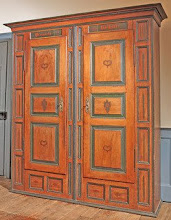 (Evidence of our travels: Hollie and I in front of the White House during a brief stop in Washington last week.)
(Evidence of our travels: Hollie and I in front of the White House during a brief stop in Washington last week.)Our most recent trip was, in some sense, like going home. Last week was the annual Furniture Forum at the Winterthur Museum (where I earned my master's degree). This year's theme was "Nature in Furniture, Furniture in Nature." Day one consisted of lectures on the use of naturalistic motifs (plants, flowers, animals, etc.) in the decoration of early American furniture. Day two complimented day one by including lectures about the use of furniture in nature; that is, garden furniture and furniture that was often moved outside for temporary use (like Windsor chairs). Robert Mussey, Brock Jobe, Wendy Cooper, Nancy Goyne Evans, Alexandra Kirtley were among the speakers, and as always, it was tremendously informative.
I was very disappointed in one aspect, however: attendance. In years past, the Forum often sold out (sometimes selling out fast, making it crucial to register early) and the auditorium was packed with over 500 attendees. This year, I only counted about 130. Sure, the economy is partly to blame...less money for extracurricular travel. And this year, the conference did not correspond to any shows (last year, it was just before the Philly shows, and in years previous, it was the same week as the Chester County Show). But I should also note that attendance at the Williamsburg Antiques Forum in February was also way down.
I think the biggest problem is the same thing we're seeing at auctions and shows: the regular attendees are aging and dying off and there is not a large number of younger folks filling those spots. Museums are struggling just as much with attracting the interest (and the admissions fees) of 20- and 30-somethings. So it seems that we in the trade should really think about reaching out to our institutional counterparts and see if we can't work together to attract new blood.
How can we do this? The first step the trade can make is to become members of local museums and attend conferences like Furniture Forum. I am routinely amazed at how few dealers and auctioneers I see at these conferences. I realize that with my academic background and my continued scholarly activities, I have more impetus to attend conferences, but wouldn't any dealer or auctioneer benefit from attendance? We're talking about listening to some of the most cutting edge research from the best scholars in the world. If a dealer or auctioneer expects to be seen as an authority among collectors, shouldn't every one of these conferences be chockablock full of dealers and auctioneers? Then why am I usually one of the very few members of the trade in attendance?

